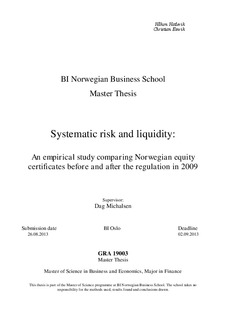Systematic risk and liquidity : an empirical study comparing Norwegian equity certificates before and after the regulation in 2009
Master thesis
Permanent lenke
http://hdl.handle.net/11250/94953Utgivelsesdato
2014-02-12Metadata
Vis full innførselSamlinger
- Master of Science [1621]
Sammendrag
In 2009, the Norwegian savings banks industry was subject to a regulation change, which resulted in a modification of the instrument issued by these banks. Thus, in this empirical study we compare the systematic risk and liquidity of equity certificates issued by Norwegian savings banks before and after the regulation change. We go about estimating systematic risk and liquidity using regression analysis. In order to estimate systematic risk we use the empirical model of the CAPM often referred to as the “Single index model”. We apply the liquidity cost measure developed by Pástor and Stambaugh (2003) to evaluate whether liquidity cost (which is a proxy for liquidity) has changed between the two sample periods. Our findings suggest that the systematic risk of equity certificates has increased, however we are unable to pinpoint whether the source for change is the regulation in 2009 or changed market dynamics due to the largest financial turmoil in modern time. Concerning liquidity, we are unable to draw any definite conclusions related to change. This is due to the weak robustness of our tests, which will make any conclusion drawn unreliable. We are however able to state that primary capital certificates seemed to be characterized by continuations in excess return related to order flow. On the contrary, this does not seem to be the case for the modified instrument.
Beskrivelse
Masteroppgave(MSc) in Master of Science in Business, Finance - Handelshøyskolen BI, 2014
